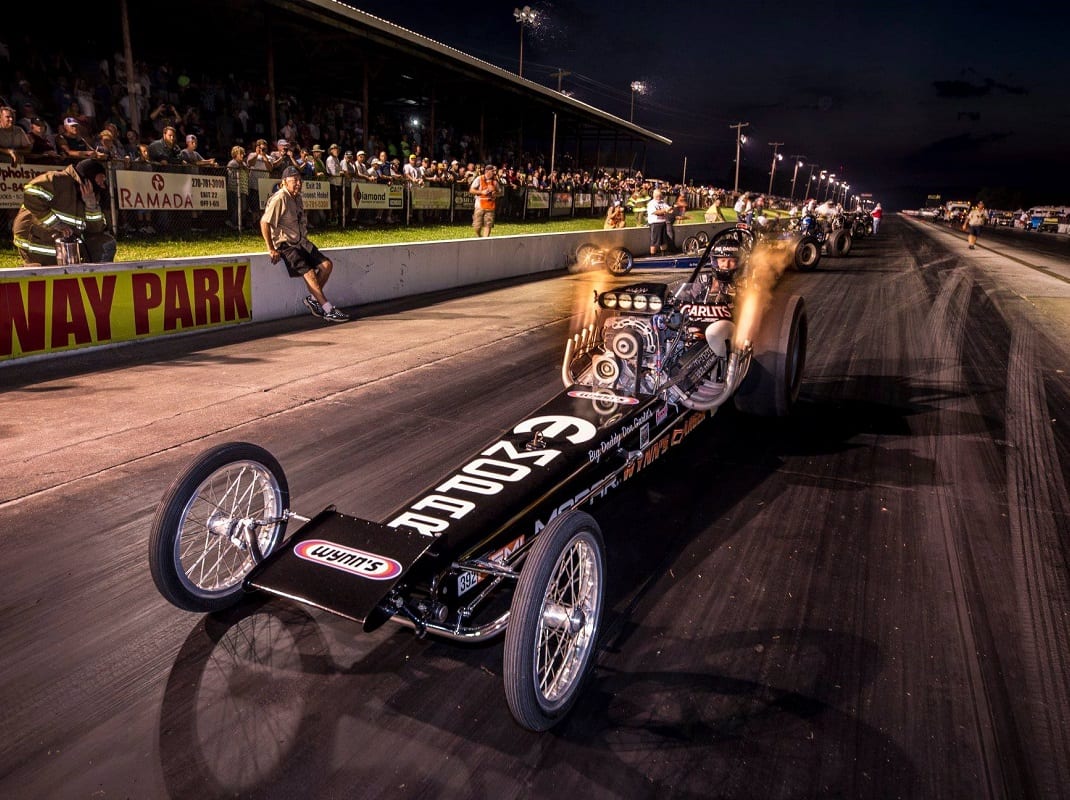Larry Dixon had just lost by one-thousandth of a second to Mike Dunn in the Top Fuel semifinals of the 2001 NHRA Winternationals at California’s Auto Club Raceway at Pomona, and he was perturbed.
But as he rode back toward the pits, brooding in the back of the tow vehicle, something caught his eye.
A rainbow of vintage, front-engine dragsters and their colorful period-correct push trucks sat ready to start and parade to the starting line in a tribute to the Golden Days of Drag Racing.
It was another edition of the relatively new phenomenon called “Cacklefest,” which had debuted during the 2000 California Hot Rod Reunion at historic Famoso Raceway in Bakersfield, Calif.
Dixon saw Tommy Ivo’s restored twin-Buick gas dragster, the copper-colored nose of Art Chrisman’s Hustler, the iconic banana-like Greer Black & Prudhomme machine that was a supreme marriage of form and function, and Kenny Safford’s blue “Sour Sisters” Olds-powered slingshot. He couldn’t miss the Magicar and its unique front-suspension design — with ace Jeep Hampshire sitting in the seat once again.
The red-and-blue Kuhl & Olson entry stood out. And there, in its scarlet glory, was THE car, the one that yanked on his heartstrings. It was the Howard Cams Rattler — with Larry Dixon Sr. in the cockpit.
“Stop for a second,” Dixon told the tow-vehicle driver. “I want to get out. I want to be a part of this deal.”
And with that, he bolted out and ran to the orange ’50 Ford that Steve Gibbs — then-curator at the Wally Parks Motorsports Museum and the primary force behind Cacklefest (a term colleague Greg Sharp coined) — was driving. Gibbs welcomed Dixon to ride along in the front seat of the push car.
Dixon took him up on his invitation but insisted, “I want to sit in the back seat.” Gibbs was puzzled. “You don’t understand,” Dixon said, “When I was a kid, push-starting off, I sat in the back seat. And I’m getting to go down the race track and have my dad push-started in a front-motor car, sitting in the back seat, just like I did when I was a little kid.”
Dixon added, “Even talking about it right now, honest to God, it gives me goosebumps. It took me back 40 years. You couldn’t have done more for me at that moment. It was so pure. I don’t know … I’m short of words on it.”
Referring to the 1970s and ’80s TV show, he said, “It was like going to ‘Fantasy Island.’ It absolutely took me to being a 7- to 10-year-old kid. Push-starting my dad and watching him race. It was the coolest thing I had done. There’s not a lot of things that are cooler in the world than being able to live that moment like that. I was almost thankful that we lost in the semis, because I wouldn’t have got that moment otherwise.”
Dixon says that was exactly the kind of emotion Gibbs must have had in mind when he came up with the concept: Trying to preserve the history of drag racing.
“There’s a lot of young people that come into the sport who have no idea of the history of it, of its roots, not knowing that guys had to push-start the cars. And bringing in the older crowd, the people that have these cars, tying them in — that’s the sport they grew up on.
“Cacklefest,” Dixon said, “feeds a lot of people, feeds their desires. There’s definitely a demand for that and there’s an absolute place for it. And if you go to one of the reunions, at Bowling Green (Ky.) or Bakersfield or even the Nitro Revivals that Steve and daughter Cindy Gibbs are doing, they’re packed with people and with cars from that era.”
Gibbs, for years the NHRA competition director, has branched out across California with his own nostalgic events, having hosted them at California’s Irwindale Speedway, Laguna Seca Raceway and Barona Speedway.
But in the beginning, as longtime journalist Cole Coonce explained it for the online publication Fuel Curve, “Restored vintage iron once campaigned by drag racing’s original slingshot gunslingers in the 1960s was fired up en masse, showcasing the smoke, the noise, and the acrid discharge of nitromethane molecules. As eight vintage fuelers simultaneously growled, spewed, and popped before the photogs and the railbirds, grown men openly wept that evening.
“These were tears of pure joy, based on a lifetime of memories.”
To continue reading, advance to the next page.
